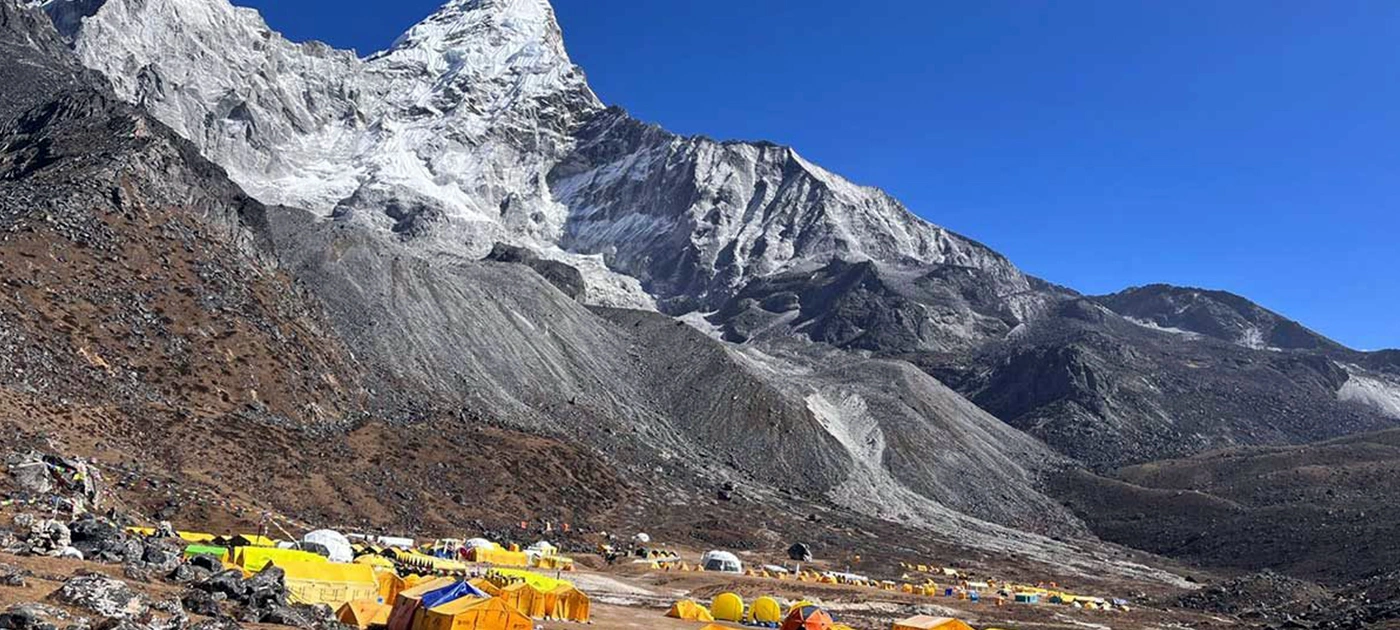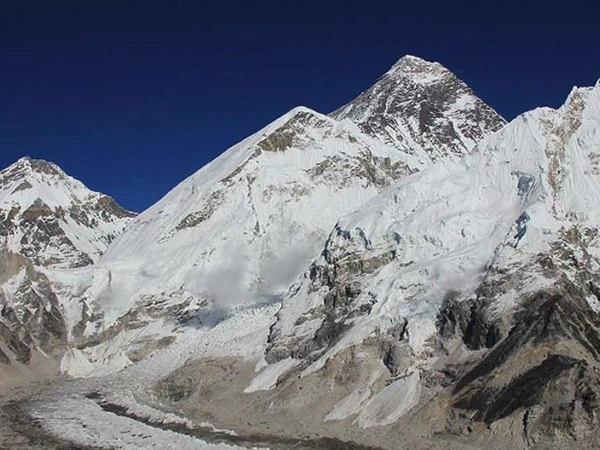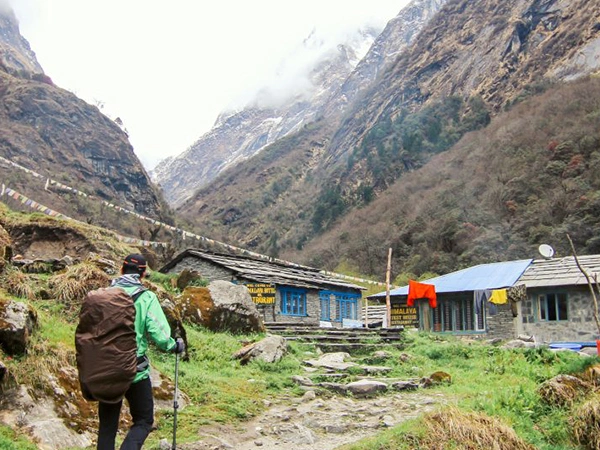The best time for Ama Dablam Base Camp trek is spring and autumn. The right season can make all the difference in your experience: weather, trail conditions, crowd levels and the availability of support services like guides, porters and accommodations.
The Ama Dablam Base Camp Trek is one of the most popular adventure holidays in the Nepal Himalayas. This trek in the breathtaking Khumbu region grants grand views of the mighty Ama Dablam (6,812 meters) and several other neighboring mountains. The journey passes through quaint Sherpa villages dotted with terraced farmland, thick forest areas and mountain ridges with views of the towering mountains all around.
The weather conditions in the Himalayas are very unpredictable. Visiting at the wrong time of the year will expose you to heavy snow, rain and extremely high winds. These may make the trails slippery, blocked or eroded. However, the weather is usually stable and the skies clear during spring and autumn, offering the best views of the mountains. The air is fresh and the trails are dry. Temperatures are moderate, neither excessively hot nor cold. All these allow for a comfortable trekking experience.
To put it all in a nutshell spring and autumn seasons are the best time for Ama Dablam Base Camp trek with favorable weather conditions, clear views and manageable temperatures. Timing your trek to coincide with these seasons will ensure an extraordinary and safe adventure.
Ama Dablam Base Camp Trek in Different Seasons
Spring (March, April and May)
Spring is one of the best seasons to trek to Ama Dablam Base Camp since the weather is stable with mild temperatures. The trekking trails are dry, making them easy and comfortable to navigate. With clear skies and low humidity you can gaze upon the sharp, ethereal views of the surrounding mountain scenery, including the mighty Ama Dablam itself.
And this is also the time when rhododendrons and other Himalayan wildflowers heavily bloom, coloring the entire landscape. The leafage of lush forests and fresh air enhanced with the fragrance of blooming flowers enrich your trekking experience immensely.
Summer/Monsoon (June, July and August)
Summer/monsoon season brings heavy rainfall and hot temperatures. While this affects trekking conditions the Ama Dablam Base Camp trek is manageable with the right preparation. Early mornings typically feature clear skies and pleasant weather. Rain usually falls around late afternoon and rejuvenates the landscape, giving way to lushness and freshness. The green valleys and meadows and rain-fed rivers and waterfalls are spectacular.
On the other hand, trekking in the monsoon is troublesome due to the wet trails. The recurrent rain makes the trails slippery and difficult to walk on. This makes it more probable for falls and injuries as well as inaccessibility of some trail sections. On top of that the threat of landslides and floods increases significantly. Likewise, as the temperatures warm up, trekking in the daytime is quite challenging due to the scorching sun. Keeping a close eye on the weather forecast before setting is very important while trekking during this time.
Autumn (September, October and November)
Autumn begins after the monsoon ends. This post monsoon time is best to trek Ama Dablam Base Camp. During autumn, the weather becomes more stable. You can enjoy clear skies, mild temperatures, clean and fresh atmosphere and crisp air. The Himalayan panorama is stark and unobstructed, standing against the deep blue cloud-free sky.
The autumn landscape is incredibly enchanting due to its rich color. The fall foliage are spectacular in shades of red, orange and yellow. These colors enrich the beauty of valleys, forests and villages. In addition, trekking in the Everest region during this time immerses you in its vibrant culture and festivals. Important festivals like Dashain, Tihar (Deepawali) and Mani Rimdu come into this time frame when local villages light up with colorful rituals, traditional music and dances.
As you pass through the different villages, you could be invited to participate in some of the celebrations or served traditional Sherpa dishes. This gives you a great appreciation and experience of the Himalayan culture.
Winter (December, January and February)
The winter in the Everest region is cold and full of snow with temperatures dropping below freezing scales. This makes the trek to Ama Dablam Base Camp a bit challenging for beginners and full of rewards for experienced trekkers.
Winter brings clear skies and Himalayan peaks are layered with fresh snow at this time. The snow covered Ama Dablam along with other neighboring mountains such as Everest, Lhotse, Nuptse, etc, are seen with greater visibility and clarity against the crystalline sky.
Winter is quieter and offers a solitary adventure experience in the mountains. You can hardly see trekkers on the trail and take on the stunning views of the surroundings all by yourself. However, the routes can be potentially icy and slippery, especially on the higher sections. Hence crampons and trekking poles are mostly essential for efficient navigation.
Best Time for Ama Dablam Base Camp Trek: Spring and Autumn
Spring and autumn present the clearest and smoothest conditions for trekking in the Everest region. The weather is characterized by clear skies, crisp air and a pleasant breeze making it the perfect time to spend outdoors. Additionally, less cloud cover and a dust-free atmosphere offer excellent visibility for viewing the magnificent Himalayas.
Likewise, the bright sunshine enhances the lighting so that you can grasp every little detail of the snow-capped peaks and rugged landscapes. Plus, the extended sunlight hours during these seasons provide enough time to explore and admire the scenery around you in all its glory.
Spring and autumn feature moderate temperatures. Days are usually warm and long, giving way to comfortable and relaxed trekking. Likewise, the trails are well-marked and dry, which are easier to walk. On the other side, these seasons coincide with vibrant festivities like Dashain, Tihar, Lhosar, Holi, Mani Rimdu etc, providing the most incredible cultural exposure during trekking.
These seasons also provide fantastic opportunities for wildlife sightings and photography. Being the peak times for birds and animal activity (migration, mating, foraging), you can have memorable encounters with diverse wildlife during this time.
Your hike to the Everest region during spring and autumn is nothing less than hypnotic. Rhododendrons and other wildflowers bloom in spring and multicolored foliage in autumn adds color to the landscapes and makes the trek way more scenic.
Spring and autumn are the most popular trekking seasons and a large number of trekkers come to visit the Himalayan regions. As a result, the trails and accommodations are busier and crowded. There can be chances of higher costs for services and potential delays in accommodations. So, do not forget to book the tea houses in advance.
Is Winter and Monsoon Trek to Ama Dablam Possible?
While trekking Ama Dablam is possible during the winter and monsoon seasons, different challenges come along. You have to bear extremely cold temperatures, snow and ice with the added risk of avalanches at higher slopes in winter. Hence, winter trekking requires proper clothing, appropriate equipment and skills.
On the other side, heavy rain pours in during monsoon and the humidity increases, obscuring visibility. Trails turn muddy and are eroded more easily. The danger of landslides and floods is greater at lower altitudes. So, planning and preparation become very important for the monsoon trek as well.
Winter Trek to Ama Dablam
The Everest region’s landscapes in winter are spectacular, blanketed with thick piles of snow. At the Ama Dablam Base Camp height of 4,600 meters, the scenery is more magical turning the rugged landscapes into a winter wonderland.
While this creates a beautiful, serene atmosphere, it can also add difficulty due to the cold temperatures, snow and ice. Snow covering the higher-altitude trails makes the terrain more challenging. Trekking on snow-piled paths requires additional preparation with specialized gear and crampons for traction.
The good sides of trekking in winter are:
- Vivid and stunning mountain views
- Clear skies
- Less crowded trails and a peaceful atmosphere
- Magical wintry landscapes
- Less insects and pests
Ama Bablam Base Camp Trek in Monsoon
The monsoon season is the least favorable time for the Ama Dablam trek. The frequent rain during this period makes the trails slippery and muddy. Likewise, the rainfall is heavy, which increases the chances of landslides and flooding. This might lead to trail closures and delays. On the other hand, due to poor visibility, navigation is difficult and mountains are barely visible.
Due to the frigid temperatures, the teahouses at alpine locations can be temporarily closed during winter. Those that are open may also limit the services. So, it is wise to know about the availability of accommodation in advance. As a whole, winter trekking demands more preparation, both gear-wise and logistically. In addition, you need to have experience handling harsh conditions.
The high sides of trekking in monsoon are:
- Cooler and quieter environment
- Lusher landscapes
- Few crowds and tranquil trails
- Refreshing atmosphere
How to Choose the Best Trekking Season?
The trek is very subjective when it comes to choosing the time of year. It entirely depends on the individual preferences of what they are looking for, be it tempting nature, rich culture or solitary moments. Consider your priorities, then pick the best time to explore this iconic Himalayan route. Whatever season you opt for, do not let the importance of weather, trail conditions, accommodation availability and safety go off as they hold the key to a successful and enjoyable trek.
For nature lovers, springis the best time as the beautiful mountainous backdrop is adorned with bright colors from blooming flowers throughout the Himalayan surroundings. This time would also let you observe some wildlife in their natural habitat, adding a thrill to the journey. However, if cultural exploration is your main focus, autumn would be the right time to come. It brings major festivals and celebrations, offering a rich cultural experience amidst the beauty of the mountains.
If you want solitude and peace away from people, winter affords you ample opportunities to enjoy the tranquil Ama Dablam Base Camp trek. There are only a few trekkers on the trail and you can immerse yourself in the magnificence of snow layered landscapes and pristine Himalayas.
The rainy season is not a good time to take on the Ama Dablam Base Camp trek because of unpredictable weather and poor trail conditions. However, it might still prove to be a great adventure for those open to a challenge. If you are acquainted with the mountain journey and are prepared for rain and sweltering heat, the monsoons offer the chance to test yourself and enjoy your trip on a more adventurous route. But it is not advisable to the beginners and the unprepared trekkers.
At the end of it all, there isn’t a time not great enough to enjoy the Ama Dablam Base Camp trek. Every season brings a different flavor to this experience.
You may also like:
- https://himalayasonfoot.com/best-time-to-go-trekking-in-nepal/
- https://himalayasonfoot.com/trip/everest-base-camp-trekking/
- https://himalayasonfoot.com/best-time-to-go-to-base-camp-mt-everest/
Unique Comparison of Different Seasons
| Spring | Autumn | Summer | Winter |
| Daytime temperature: mild to warm (10 to 20 degrees Celcius) | Daytime temperature: mild to cool (10 to 15 degrees Celcius) | Daytime temperature: warm (15 to 25 degrees Celcius) | Daytime temperature: cold (0 to 10 degrees Celcius) |
| Nighttime temperature: cold (-5 to -10 degrees Celcius) | Nighttime temperature: cold (-5 to -10 degrees Celcius) | Nighttime temperature: cool (10 to 15 degrees Celcius) | Nighttime temperature: very cold (-10 to -20 degrees Celcius) |
| Visibility: Occasional clouds but unobstructed views most times | Visibility: clear skies and excellent views | Visibility: poor visibility with rain and fog | Visibility: clear skies, snow-covered views |
| Trail conditions: mostly dry with occasional wet patches | Trail conditions: dry and well-defined | Trail conditions: wet, muddy, slippery | Trail conditions: snowy and icy |
| Crowds: moderate to high (popular season) | Crowds: high (peak season) | Crowds: very low (off-season) | Crowds: low (off-season) |
| Highlights: blooming landscapes, clear skies, elegant mountain views | Highlights: fall foliages, cloudless sky, unobstructed views | Highlights: fewer crowds, lush greenery | Highlights: snow wonderland, solitary experience |
Suggested Time to Trek Ama Dablam Base Camp
Weather in the mountains is always unpredictable and can change anytime without giving any warnings. Hence, timing is crucial for any successful trek in the Himalayas. Speaking from my perspective, spring and autumn are really the ideal seasons for making this incredible trek.
In these two seasons, generally, the conditions are the most favorable for trekking. Weather is stable, temperatures are not extreme and rain or snowfall is minimal. This makes trekking quite comfortable and enjoyable. Further is added by the clear skies, dry trails and extended daylight hours.
It is perfect for nature blooms, spectacular mountain scenery and fresh air during the spring. On the other hand, autumn comes with colorful foliage and similar advantages of clear weather and visibility.
If you are more comfortable in moderate conditions, then autumn and spring are your best bets. But if you can also handle the challenges of extreme cold or heat, then winter or summer trekking can be appealing.
Important Tips for the Ama Dablam Trek in Different Seasons
Packing
- The temperature in the alpine locations of the Himalayas is extremely cold, with heavy snowfall, especially during the winter months. Pack boots with crampons, warm thermal clothing and reliable trekking poles to stay prepared.
- A monsoon is a period of high-frequency rain. Pack durable rain gear that will keep you dry. The trails get really muddy and slippery which requires water-resistant boots with good traction. Additionally, stable trekking poles and moisture-wicking socks are needed to help make walking in wet conditions comfortable.
- Summer is quite hot, so pack lightweight and breathable clothing that dries quickly.
- The unending rain of the monsoon may give way to leeches and other insects in the lower hills and forests. Bring bug spray and wear long-sleeved clothes to minimize insect bites.
- With the summer sun beating down relentlessly, remember to pack in SPF 50+ sunscreen and apply it frequently to prevent tanned skin or sunburn. Further, a wide-brimmed sun hat and UV-protective sunglasses are useful against strong UV rays.
- Finally, do not forget to take your camera to shoot amazing landscapes, wildlife, mountainside villages, local life, flora, fauna and whatnot. The possibilities of photography in the Himalayas are limitless.
Reservations
- Spring and autumn are peak times for treks in the Himalayas, so it is usually pretty crowded. So, it is necessary to make reservations in advance for logistics like transportation, accommodation, permits etc.
- The monsoon and winter seasons are not favorable times to trek in the mountains and teahouses can get closed during this time. Hence, confirmation of accommodation availability should be made in advance to avoid inconvenience.
Weather Updates and Flexibility
- Winter weather can be really unpredictable, with sudden snowstorms and fog that limit visibility. Keep checking the weather updates from time to time and be ready for sudden changes in weather conditions.
- Flights between Kathmandu and Lukla might be delayed due to monsoon rains, so it is always worth it to have extra days in your itinerary.
- Because of shorter daylight hours during winter, you should start the trek early in order to make the most of better conditions and reach the destination before nightfall.
- It is also important to start early every day to avoid midday heat and afternoon cloud cover.





![Best Time to Do the Tsum Valley Trek in Nepal [With Trekking Tips]](https://himalayasonfoot.com/uploads/blog/best-time-to-do-the-tsum-valley-trek-in-nepal.webp)
